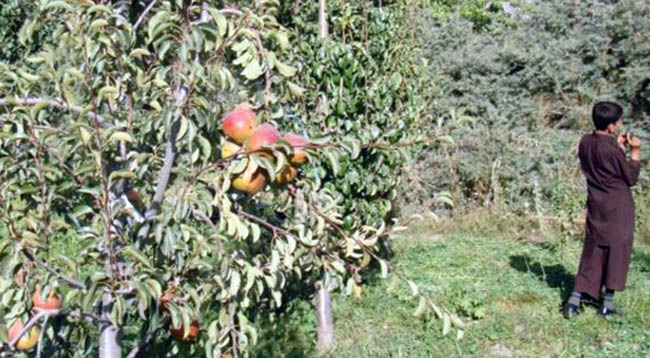Agriculture and agriculture-related industries are fundamental means of livelihood in Afghanistan, generating 50% of the country’s GDP and supporting 85% of its people. The climate of Afghanistan is well suited for the cultivation of horticultural crops and Afghanistan is the geographic origin of many high-end crops like raisins, pomegranates, pistachios and almonds. There are approximately one million farms in Afghanistan and more than 2,000 wholesalers for horticulture products. According to figures from the Afghanistan Chamber of Commerce and Industries, Afghanistan yearly exports value more than $700 million, with fruits forming a majority of this value but Afghanistan’s yearly import stands at more than $6 billion. Intensive commercial farming increases sustainable economic growth in rural areas, encourages competition, contributes to regional development and helps sustain the growth of private businesses related to it. Investment in agro-business and agro-processing will make a positive impact on the economic development of Afghanistan and will feed millions more people if the agricultural industry gets rid of current challenges. It should be the goal of a modern agricultural sector for Afghanistan to become self-sufficient again and subsequently be able to expand into an export industry.
The first issue related to the agricultural sector is packaging which is entirely outdated and damage fresh goods en route to markets and prevents an effective export business for many crops. It said that some 20-40% of post-harvest horticulture products are wasted because of poor packaging. Lack of modern machinery, such as grain cleaning and sieving equipment for flour, and tractor trolleys, is another burrier to the production of agricultural goods. In the long term, the manufacture of local machinery is important to the agricultural industry and also can be a good opportunity to the investors for this gap.
The next pressing issue is lack of cold rooms for storage of local agricultural products. Fruits and vegetables are perishable products and it is estimated that in Afghanistan 30 percent of the fresh fruit and 20 percent of the fresh vegetables are lost because of rapid quality deterioration after harvest, mainly due to poor product handling and improper storage; further, about 40 percent of fresh fruit and 40 percent of fresh vegetables reduce their value before they are bought by the final consumers. Thus, only 30 and 40 percent of the fresh fruits and vegetables, respectively, are sold without price reduction.
Thus the biological cycles of crops and weather conditions, produce production is seasonal and their market value is determined by supply and demand. At harvest, supply is at its peak and prices are low, as market supply weakens prices start to climb, reaching a peak when supply is lowest. The strategy for cold room storage management is to buy cheap, to process and store the produce and sell it when the difference between the selling and purchasing price is largest after subtracting the storage cost. Implementation of this strategy requires knowledge of how the markets work. However, market price intelligence is poor. Rapidly changing prices constitute a challenge to organize a cold storage strategy that takes advantage of produce price seasonality.
Traders of neighboring countries buy Afghan agricultural products at low cost during the harvest season and take the production to their country for processing and cold storage close to the Afghan border. Eventually, when demand for the production is high and the supply is low in Afghanistan, the traders bring the same production back to the country of origin and sell it at premium prices. Almost One month ago, the retail price for a bag of 7kg apple in Kabul market was around 80af but now it is risen up to 400af. Recently, I bought a kg of 20kg onion at 80af but a few months later it will increase up to 400 or 500af. Same is the case with many other products.
Although, a number cold rooms have been initiated within last 15 years but due to power irregularities and its high cost they do not satisfy the needs of Afghan farmers. The annual production of fruits and vegetables in Afghanistan is one and four million metric tons, respectively. The prospect for cold room development for fruits and vegetables exceeds 5000 cold rooms, each with 25 metric tons capacity. These cold rooms could store about 400,000 to 450,000 metric tons of produce year around. Currently, the operating cost of cold rooms is as high as the majority of consumers are unwilling to pay a premium prices for fresh produce out of season.
Overall, the process of purchasing, processing, storing and selling produce at a particular time and in a particular market involves an organized supply chain of goods, services and investment. Consumers can benefit from the cold room units because the produce is kept fresh longer (out of season). Producers benefit because farm gate prices tend to be higher and less volatile. Managers of the cold room storage facilities sell fresh produce at premium prices when seasonal supply has declined and have the option for exporting produce if linkages are established with markets.
Bottom of Form on the other hand, agricultural products are the essential part of Afghan economy but the cold storage systems (CSS) is still in an embryonic stage. So, It is highly important to draw the attention of government or private investors the establishing new colds roams and improve handling practices inside Afghanistan. Off season produce can be offered to consumers fresh at premium prices; thus, cold rooms can be used as instruments to link consumers’ demand and organized supply.
Home » Opinion » The Agricultural Challenges
The Agricultural Challenges
| Mohammad Zahir Akbari

